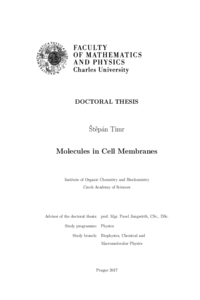Molecules in Cell Membranes
Molekuly v buněčných membránách
dissertation thesis (DEFENDED)

View/
Permanent link
http://hdl.handle.net/20.500.11956/91181Identifiers
Study Information System: 134709
CU Caralogue: 990021542150106986
Collections
- Kvalifikační práce [11964]
Author
Advisor
Consultant
Lazar, Josef
Referee
Böckman, Rainer
Ettrich, Rüdiger
Faculty / Institute
Faculty of Mathematics and Physics
Discipline
Biophysics, Chemical and Macromolecular Physics
Department (external)
Information is unavailable
Date of defense
14. 9. 2017
Publisher
Univerzita Karlova, Matematicko-fyzikální fakultaLanguage
English
Grade
Pass
Keywords (Czech)
biologické membrány, molekulová dynamika, fluorescenční sondy, rekoverin, myristoylový přepínačKeywords (English)
biological membranes, molecular dynamics, fluorescent probes, recoverin, myristoyl switchBiologické membrány se aktivně účastní řady procesů v živých buňkách, a detailní popis jejich struktury, dynamiky a funkce je tudíž nezbytný pro porozumění živým organismům na molekulární úrovni. V této práci jsme využili vysoké časové a prostorové rozlišení poskytované počítačovými simulacemi pro výzkum chování několika druhů molekul, které se mohou vázat do membrán buněk. Kombinace klasických simulací molekulové dynamiky a ab initio výpočtů elektronové struktury nám dovolila charakterizovat optické vlastnosti fluorescenčních sond zanořených v membránách, a tím přispět k rozvoji dvoufotonové polarizační mikroskopie jako nástroje strukturní biologie. Simulace molekulové dynamiky nám dále umožnily popsat na atomární úrovni vratnou vazbu rekoverinu k membráně a rovněž poskytly významný vhled do mechanismu vápníkem indukovaného myristoylového přepínače tohoto proteinu, důležitého pro adaptaci zrakových buněk. Kromě toho jsme zkoumali biologickou úlohu oxidace cholesterolu a porovnali dvě metody popisu membránového napětí v simulacích molekulové dynamiky.
Biological membranes are actively involved in a multitude of processes in living cells; therefore, a detailed characterization of their structure, dynamics, and function is essential for an understanding of living organisms at the molecular level. In this work, we made use of the high spatial and temporal resolution offered by computer simulations to investigate the behavior of several molecular species which associate with cellular membranes. Using a combination of classical molecular dynamics simulations and ab initio electronic structure calculations, we were able to characterize nonlinear optical properties of membrane- embedded fluorescent probes and thus contribute to establishing two-photon polarization microscopy as a tool of structural biology. Moreover, our molecular dynamics simulations provided an atomistic picture of the reversible membrane binding of recoverin, a neuronal calcium-sensing protein involved in vision adaptation, and they also yielded an important insight into the mechanism of its calcium-induced myristoyl switch. In addition, we examined the biological role of cholesterol oxidation and compared two methods of representing transmembrane voltage in molecular dynamics simulations.
